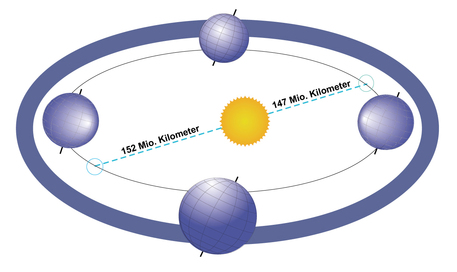When is Earth closest to Sun?
Close to the sun and freezing
Every year, the Earth actually makes its closest approach to the Sun in early January, when it is winter here in the northern hemisphere. This year, it happened at 10:23 am Eastern Standard Time on January 4th - at that time the Earth and the Sun were "just" 147 million kilometers apart.
 © Horst Frank/GFDL
|
The figure gives a schematic overview of important points in the Earth's orbit: The points at which it is nearest and furthest from the Sun (the blue circles at the top right and bottom left of the image, respectively)
You can see this at the top right of the image. In early July, the Earth reaches the most distant point in its orbit around the Sun (at the bottom left of the image). The distance between the Earth and the Sun is then about 152 million kilometers, while at the same time it is midsummer in these latitudes. This means that the seasonal differences in temperatures cannot be caused by the separation between the Earth and the Sun.
The tilt of the Earth's axis, rather than the distance between Earth and Sun, causes the seasons.
The seasons are caused by the tilt of the Earth’s axis. The Earth’s axis, which connects the geographic North Pole and the geographic South Pole, is not perpendicular to its orbit but instead is tilted by 23.4 degrees. This means that during the year it takes for the Earth to orbit around the Sun, either the northern or the southern hemisphere is titled towards the Sun.
On June 21st (summer solstice, on the left of the image), the northern hemisphere is most tilted towards the Sun. This means that the rays of the Sun fall more directly on the northern hemisphere, causing it to heat up - it is summer in this part of the world. At the same time it is winter in the southern hemisphere because the rays of the Sun strike it at a smaller angle, causing the heat radiation from the Sun to be spread over a larger area. On December 21st (winter solstice, on the right of the image) the situation is exactly reversed - it is winter in our part of the world while it is summer in the southern hemisphere.
German Aerospace Center
The tilt of the Earth's axis, rather than the distance between Earth and Sun, causes the seasons.
The seasons are caused by the tilt of the Earth’s axis. The Earth’s axis, which connects the geographic North Pole and the geographic South Pole, is not perpendicular to its orbit but instead is tilted by 23.4 degrees. This means that during the year it takes for the Earth to orbit around the Sun, either the northern or the southern hemisphere is titled towards the Sun.
On June 21st (summer solstice, on the left of the image), the northern hemisphere is most tilted towards the Sun. This means that the rays of the Sun fall more directly on the northern hemisphere, causing it to heat up - it is summer in this part of the world. At the same time it is winter in the southern hemisphere because the rays of the Sun strike it at a smaller angle, causing the heat radiation from the Sun to be spread over a larger area. On December 21st (winter solstice, on the right of the image) the situation is exactly reversed - it is winter in our part of the world while it is summer in the southern hemisphere.
German Aerospace Center
When is Earth closest to Sun?
Close to the sun and freezing
Every year, the Earth actually makes its closest approach to the Sun in early January, when it is winter here in the northern hemisphere. This year, it happened at 10:23 am Eastern Standard Time on January 4th - at that time the Earth and the Sun were "just" 147 million kilometers apart.
 © Horst Frank/GFDL
|
The figure gives a schematic overview of important points in the Earth's orbit: The points at which it is nearest and furthest from the Sun (the blue circles at the top right and bottom left of the image, respectively)
You can see this at the top right of the image. In early July, the Earth reaches the most distant point in its orbit around the Sun (at the bottom left of the image). The distance between the Earth and the Sun is then about 152 million kilometers, while at the same time it is midsummer in these latitudes. This means that the seasonal differences in temperatures cannot be caused by the separation between the Earth and the Sun.
The tilt of the Earth's axis, rather than the distance between Earth and Sun, causes the seasons.
The seasons are caused by the tilt of the Earth’s axis. The Earth’s axis, which connects the geographic North Pole and the geographic South Pole, is not perpendicular to its orbit but instead is tilted by 23.4 degrees. This means that during the year it takes for the Earth to orbit around the Sun, either the northern or the southern hemisphere is titled towards the Sun.
On June 21st (summer solstice, on the left of the image), the northern hemisphere is most tilted towards the Sun. This means that the rays of the Sun fall more directly on the northern hemisphere, causing it to heat up - it is summer in this part of the world. At the same time it is winter in the southern hemisphere because the rays of the Sun strike it at a smaller angle, causing the heat radiation from the Sun to be spread over a larger area. On December 21st (winter solstice, on the right of the image) the situation is exactly reversed - it is winter in our part of the world while it is summer in the southern hemisphere.
German Aerospace Center
The tilt of the Earth's axis, rather than the distance between Earth and Sun, causes the seasons.
The seasons are caused by the tilt of the Earth’s axis. The Earth’s axis, which connects the geographic North Pole and the geographic South Pole, is not perpendicular to its orbit but instead is tilted by 23.4 degrees. This means that during the year it takes for the Earth to orbit around the Sun, either the northern or the southern hemisphere is titled towards the Sun.
On June 21st (summer solstice, on the left of the image), the northern hemisphere is most tilted towards the Sun. This means that the rays of the Sun fall more directly on the northern hemisphere, causing it to heat up - it is summer in this part of the world. At the same time it is winter in the southern hemisphere because the rays of the Sun strike it at a smaller angle, causing the heat radiation from the Sun to be spread over a larger area. On December 21st (winter solstice, on the right of the image) the situation is exactly reversed - it is winter in our part of the world while it is summer in the southern hemisphere.
German Aerospace Center





